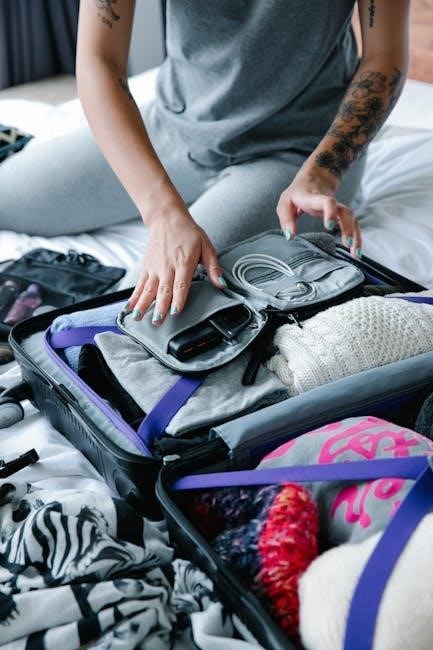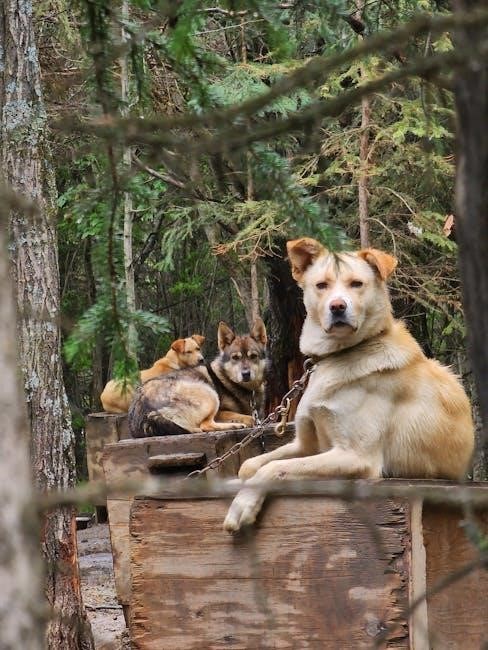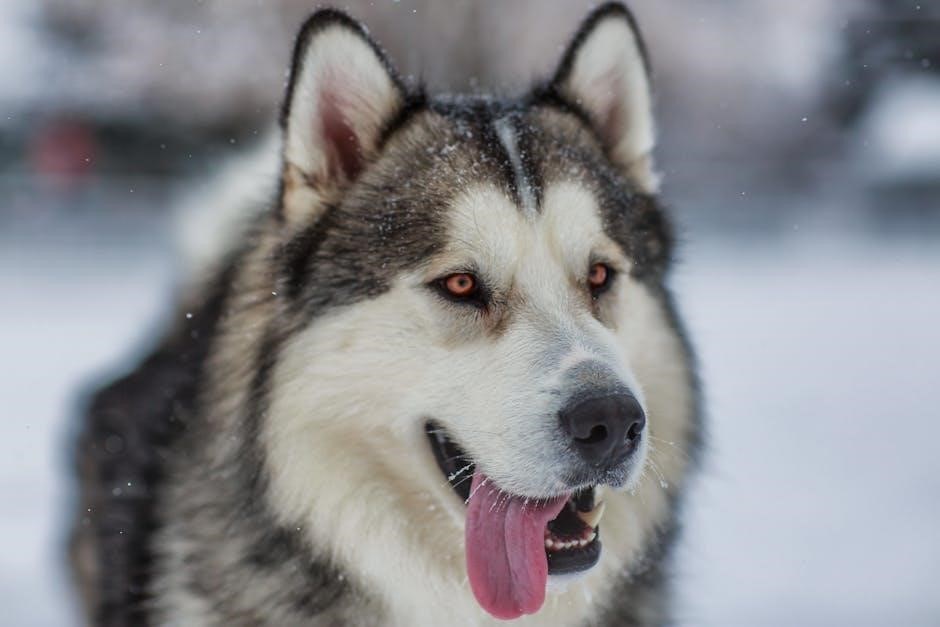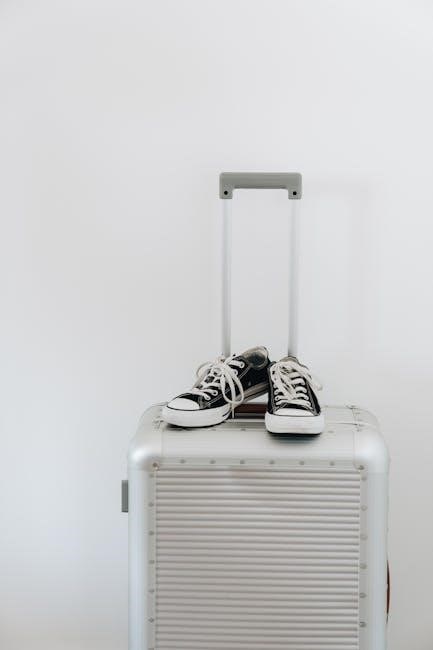
alaska packing list pdf
Alaska’s vast wilderness and extreme weather demand a specialized packing strategy. This guide provides a comprehensive list of essentials, ensuring preparedness for diverse landscapes and activities.
1.1 Why Alaska Requires a Specialized Packing List
Alaska’s extreme weather, vast wilderness, and diverse wildlife demand a tailored packing approach. Harsh winters, unpredictable conditions, and remote locations necessitate specific gear. From insulated clothing to bear spray, every item must be carefully chosen to ensure safety and comfort in this unique environment. A well-prepared list is crucial for navigating Alaska’s unparalleled outdoor challenges.
1.2 Key Factors to Consider When Packing for Alaska
When packing for Alaska, consider the season, activity type, and location. Weather extremes, such as freezing temperatures or rain, require durable gear. Remote areas may lack amenities, so essentials like first aid and navigation tools are vital. Layering clothing and choosing multi-use items can save space and enhance functionality during your trip.

Essential Items to Pack
Pack thermal layers, waterproof gear, sturdy footwear, and essentials like hats, gloves, and sunglasses. Include versatile accessories for varying weather and outdoor activities in Alaska.
2.1 Clothing for Extreme Weather Conditions
Alaska’s harsh climate requires layered, breathable clothing. Include thermal base layers, insulated jackets, and waterproof pants. Choose moisture-wicking fabrics for cold and wet conditions. Don’t forget warm hats, gloves, and scarves. Opt for durable materials that withstand extreme temperatures and wind; Consider bringing lightweight yet warm options for varying weather scenarios. Proper clothing ensures comfort and safety during outdoor adventures in Alaska’s unpredictable environment.
2.2 Footwear for Hiking and Outdoor Activities
Sturdy footwear is essential for Alaska’s rugged terrain, protecting against harsh conditions. Choose insulated, waterproof boots with deep treads for superior grip. Opt for hiking boots, snow boots, or trail runners depending on your adventure. Ensure they are waterproof and provide excellent ankle support. Consider moisture-wicking socks to keep feet dry and comfortable. For deep snow, gaiters can prevent debris from entering boots. Invest in durable footwear to handle Alaska’s diverse landscapes confidently.
2.3 Must-Have Gear for Outdoor Adventures
Essential outdoor gear includes a lightweight tent, sleeping bag, and portable stove for camping. A waterproof backpack keeps items dry, while a map and compass or GPS ensure navigation. Don’t forget a first-aid kit, headlamp, and extra batteries. For fishing or kayaking, bring appropriate equipment. Always carry bear spray and a whistle for safety in remote areas. Pack gear that’s durable and versatile for various activities.

Important Documents and Safety Items
Always carry ID, travel insurance, and emergency contacts. Include a first-aid kit, headlamp, whistle, and bear spray for safety in remote areas. Stay prepared and visible.
3.1 Travel Documents and Identification
Ensure you pack essential travel documents like your passport, visa, ID, and travel insurance. Carry photocopies and digital backups for emergencies. Include a detailed itinerary and hotel reservations. Don’t forget a valid driver’s license if planning to rent a car; Keeping these documents organized and easily accessible is crucial for smooth travel in Alaska.
3.2 Safety Gear for Remote Areas
When venturing into Alaska’s remote regions, pack essential safety gear such as a first aid kit, emergency shelter, and navigation tools. Include a compass, map, and GPS device. Bring bear spray for wildlife encounters. A portable communication device, like a satellite phone, is crucial for areas with no cell service. Don’t forget a headlamp, extra batteries, and a fire starter for unexpected overnight stays. Always carry emergency rations and a water purification system to ensure survival in isolated areas.

Health and Wellness Essentials
Pack a comprehensive first aid kit with bandages, antiseptics, and pain relievers. Include personal medications, insect repellent, and a water purification system to stay healthy and safe.
4.1 First Aid Kit for Wilderness Trips
A wilderness first aid kit should include bandages, antiseptics, pain relievers, and supplies for blisters or sprains. Add personal medications, gloves, and a small guide for emergency procedures. Include items like moleskin, splints, and medical tape to handle injuries in remote areas where medical help may be unavailable. Always tailor the kit to your group size and trip duration.
4.2 Medications and Personal Health Items
Pack essential medications, including prescriptions, allergy relief, and altitude sickness remedies. Bring personal health items like hand sanitizer, insect repellent, and sunscreen. Include gastrointestinal relief for digestive issues. Don’t forget feminine hygiene products, contact lenses, or glasses if needed. Organize medications in a clear, accessible bag with labels for easy identification during emergencies or routine use.
Electronics and Communication Devices
Bring a camera for stunning landscapes, portable chargers, and power banks for reliable energy. Include a smartphone, GPS, and two-way radios for communication in remote areas.
5.1 Cameras for Capturing Scenic Landscapes
A DSLR or mirrorless camera is ideal for Alaska’s breathtaking views. Bring extra batteries, memory cards, and a tripod for stability. Protect your gear with a weather-resistant case to withstand harsh conditions. A wide-angle lens captures expansive landscapes, while a telephoto lens is perfect for wildlife photography. Don’t forget a portable charger to keep your devices powered throughout your adventure.
5.2 Portable Chargers and Power Banks
Alaska’s remote areas often lack power outlets, making portable chargers essential. Opt for high-capacity power banks with multiple USB ports. Solar chargers are a great backup option, especially for extended trips. Pack lightweight, compact designs to save space and ensure your devices stay powered throughout your journey. Don’t forget compatible cables and adapters for all your electronics.
Animal and Wildlife Considerations
Alaska’s wildlife requires careful preparation. Include bear spray, sturdy containers, and pet-friendly gear to ensure safety and compliance with local regulations during your adventure.
6.1 Bear Spray and Wildlife Deterrents
Bear spray is a crucial defense against encounters with bears and other wildlife. Choose an EPA-approved formula with at least 1% capsaicin. Keep it easily accessible and ensure it’s not expired. Consider carrying additional deterrents like noise-making devices or pepper spray for smaller animals. Proper storage and handling are essential to avoid accidents during your trip.
6.2 Pet-Friendly Packing Tips
When traveling with pets in Alaska, pack essentials like food, water, bowls, and a leash. Include pet ID tags, a first-aid kit, and medication. Bring a portable bed or crate for comfort. Consider weather-appropriate gear like jackets or booties. Always carry waste bags and ensure your pet’s vaccinations are up-to-date. Research pet-friendly accommodations and activities in advance to ensure a smooth trip.
Vehicle and Travel Preparation
Ensure your vehicle is ready for Alaska’s rugged terrain with a well-stocked emergency kit, proper maintenance checks, and reliable navigation tools for safe and enjoyable travel.
7.1 Car Essentials for Long-Distance Travel
For long-distance travel in Alaska, pack a car emergency kit with jumper cables, flashlight, first aid kit, and ice scraper. Include a spare tire, oil, and coolant. Ensure reliable navigation with a GPS device or maps. Bring a portable phone charger and snacks for sustenance. Winter driving requires chains and a blanket for emergency situations.
7.2 Tips for Winter Driving in Alaska
Winter driving in Alaska requires caution and preparation. Slow down on icy roads and maintain a safe distance. Use winter tires or chains for traction. Keep headlights on for visibility. Carry an emergency kit with blankets, flashlights, and snacks. Avoid sudden movements and know how to handle skidding. Stay informed about road conditions and weather forecasts before departing.

Day Pack and Daily Essentials
A day pack is crucial for daily excursions, carrying water, snacks, a first aid kit, and a map. Pack lightweight yet practical items for convenience.
8.1 What to Carry for Day Trips
For day trips in Alaska, pack essentials like a reusable water bottle, energy-rich snacks, a compact first aid kit, and a detailed map. Include extra layers, rain gear, and a portable phone charger. Don’t forget sun protection, insect repellent, and a lightweight emergency shelter. Check the weather forecast and adjust your items accordingly for a safe and enjoyable adventure.
8.2 Reusable Water Bottles and Snacks
Stay hydrated and energized with a durable, BPA-free reusable water bottle. Opt for lightweight, high-calorie snacks like nuts, dried fruits, and jerky. Consider freeze-dried meals for extended trips. Avoid single-use plastics to reduce environmental impact. Choose snacks resistant to melting or spoilage, ensuring you remain fueled throughout your Alaskan adventures;

Seasonal Packing Checklists
Adjust your packing based on Alaska’s seasons. Summer requires lightweight layers, while winter demands heavy insulation. Tailor your essentials to the specific time of year you visit.
9.1 Summer Packing List
For Alaska’s summer, pack breathable, moisture-wicking clothing and layers for cooler evenings. Include sturdy hiking boots, insect repellent, and rain gear. Don’t forget sunglasses, a hat, and sunscreen for long daylight hours. Bring a lightweight jacket for breezy nights and a reusable water bottle to stay hydrated during outdoor adventures.
9.2 Winter Packing List
Alaska’s harsh winters require thermally insulated gear. Pack a heavy-duty parka, insulated snow pants, gloves, scarves, and warm hats. Include thermal base layers, waterproof boots, and goggles for snow activities. Don’t forget a cozy blanket, hand warmers, and a reliable ice scraper for vehicles. Ensure all items are water-resistant to withstand extreme cold and moisture.

Tips for Minimizing Luggage
Pack multipurpose items and choose versatile clothing to reduce space. Roll clothes to save room and avoid overpacking. Use compact gear to keep luggage light and efficient.
10.1 How to Pack Light for Alaska
Packing light for Alaska involves selecting versatile, multi-use items. Choose layers of breathable, moisture-wicking fabrics for varying weather conditions. Opt for compact gear and avoid duplicates. Roll clothing to maximize space and minimize bulk. Prioritize essentials like waterproof jackets and sturdy footwear. Consider the activities you’ll do most and pack accordingly. This approach ensures efficiency without sacrificing comfort or preparedness.
10.2 Multi-Purpose Items to Save Space
Multi-purpose items are key to efficient packing. Use a sarong as a blanket, towel, or dress. Pack travel-sized toiletries and reusable containers. A portable power bank charges devices, while a Swiss Army knife offers versatility. Include quick-dry clothing that doubles as swimwear. These items reduce luggage space while maintaining functionality, ensuring you stay prepared without overpacking for your Alaskan adventure.
Common Packing Mistakes to Avoid
Overpacking and underpacking are common errors. Forgetting essential gear like bear spray or proper footwear can be risky. Ensure you strike the right balance for Alaska’s unique conditions.
11.1 Overpacking and Underpacking Errors
Overpacking burdens travelers with unnecessary weight, while underpacking risks missing essentials. Common mistakes include bringing too many clothes or forgetting critical gear like bear spray. Balance is key to ensuring comfort and safety without sacrificing mobility. Evaluate each item’s necessity and pack versatile, multi-use belongings to avoid these pitfalls during your Alaska adventure.
11.2 Forgetting Essential Gear
Forgetting critical items like headlamps, rain gear, or insect repellent can disrupt plans and pose safety risks. Common oversights include leaving behind bear spray, thermal layers, or waterproof bags. Double-checking your list ensures all must-haves are included, preventing avoidable challenges in Alaska’s rugged environment. Prioritize essentials to avoid unnecessary setbacks during your journey.

Budgeting and Shopping for Gear
Budgeting for Alaska gear requires careful planning to avoid overspending. Compare prices, seek second-hand options, and prioritize multi-use items to maximize savings without compromising quality or safety.
12.1 Affordable Options for Quality Gear
Exploring budget-friendly options for quality gear is crucial for an Alaska trip. Consider purchasing second-hand equipment from outdoor stores or online marketplaces, which often offer durable items at reduced prices. Additionally, seasonal sales and discount codes can help you acquire essential gear without breaking the bank, ensuring you stay prepared without compromising on quality or safety.
12.2 Rental Options for Specialized Equipment
Renting specialized gear can be a cost-effective and convenient option for your Alaska adventure. Many local outfitters offer high-quality equipment rentals, such as winter gear, camping equipment, and outdoor gear. This approach saves space in your luggage and reduces the need for long-term investments. Online platforms also provide rental services, making it easier to access the gear you need without the financial burden of purchasing.

Creating a Printable Alaska Packing List PDF
A well-organized PDF ensures efficiency and stress-free preparation. Include clear sections, checkboxes, and a clean layout for easy customization and tracking of essentials during your Alaska adventure.
13.1 Designing a User-Friendly PDF
A user-friendly PDF should prioritize clarity and readability. Use standard fonts, bullet points, and logical sections to organize information. Ensure proper spacing and avoid clutter. Incorporate bold headings and clear categories to make navigation easy. Add visual cues like icons or color-coding for quick reference. Include placeholders for notes or checkboxes to enhance customization. Ensure the PDF is mobile-friendly and easily printable. A well-designed layout enhances usability and ensures travelers can focus on their adventure.
13.2 Adding Checkboxes for Easy Tracking
Adding checkboxes to your Alaska packing list PDF simplifies tracking progress. Each item can be marked off as it’s packed, reducing the risk of forgetting essentials. Use customizable checkboxes that stand out visually, ensuring they’re easy to locate. This feature enhances organization and provides a sense of accomplishment as tasks are completed. It’s especially useful for large or complex lists, making pre-trip preparations more efficient and stress-free.

Popular Alaska Destinations and Their Packing Needs
Alaska’s diverse destinations require tailored packing strategies. National parks and urban areas have unique needs, ensuring your list adapts to each location’s specific demands and activities.
14.1 Packing for National Parks
Packing for Alaska’s national parks requires a well-organized list due to remote locations and unpredictable weather. Essentials include layers, waterproof clothing, sturdy boots, and a first aid kit. Bear spray is a must for wildlife safety. Don’t forget navigation tools, a headlamp, and a portable stove for camping. Always check park-specific regulations and pack extra supplies for emergencies. Be prepared for breathtaking adventures in nature.
14.2 Urban vs. Wilderness Packing Differences
Urban areas like Juneau or Anchorage require lighter, versatile clothing and toiletries, while wilderness trips demand rugged gear. Pack formalwear for city events but prioritize layers, waterproof items, and survival tools for remote adventures. Urban stays may need less bulky items, whereas wilderness excursions require durable, weather-resistant equipment. Adjust your list based on the environment to ensure comfort and safety in both settings.
Preparation is key to a successful Alaskan adventure. A well-organized packing list ensures safety, comfort, and the ability to fully enjoy the breathtaking landscapes and experiences Alaska offers.
15.1 Final Tips for a Successful Alaska Trip
Plan meticulously, pack layers for unpredictable weather, and stay informed about local conditions. Carry a reusable water bottle, snacks, and essential gear. Respect wildlife and nature, and consider renting specialized equipment to save space. Ensure all documents are up-to-date and easily accessible. Stay flexible and open to new experiences, embracing Alaska’s unique beauty and challenges with confidence.
15.2 Importance of Being Prepared
Alaska’s unpredictable environment demands thorough preparation. Pack essential gear, check weather forecasts, and carry safety items like bear spray. Respect the wilderness and wildlife, ensuring a safe and enjoyable trip. Being prepared enhances your experience, allowing you to focus on the breathtaking landscapes and unique opportunities Alaska offers, while minimizing risks and ensuring a memorable adventure.